AFFH: Four Letters that Spell TROUBLE
Gregory Hood, American Renaissance, September 18, 2020
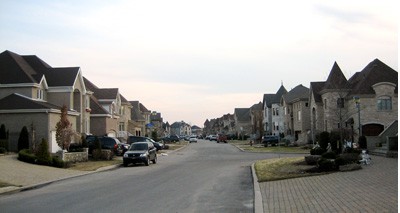
President Donald Trump is losing the suburbs. A June poll found that 65 percent of suburban voters had a favorable view of Black Lives Matter. A more recent poll reports that most Midwestern voters prefer Joe Biden over President Trump on race relations, protests, and “law and order.” Just 11 percent of suburban white voters said being “tough on crime” was their top issue; far more thought handling the pandemic was most important — and they thought Mr. Trump was doing a bad job with Covid-19. Suburban women strongly favor Mr. Biden over Mr. Trump. President Trump better hope that there is silent support in the suburbs, even as he tries to “save” them.
At the request of many great Americans who live in the Suburbs, and others, I am studying the AFFH housing regulation that is having a devastating impact on these once thriving Suburban areas. Corrupt Joe Biden wants to make them MUCH WORSE. Not fair to homeowners, I may END!
— Donald J. Trump (@realDonaldTrump) July 1, 2020
Sleepy Joe Biden has pledged to ABOLISH Suburban Communites as they currently exist by reinstating Obama’s radical AFFH Regulation. There goes Suburbia!
— Donald J. Trump (@realDonaldTrump) September 8, 2020
So what’s AFFH? “Affirmatively Furthering Fair Housing” is a rule proposed by President Obama’s Department of Housing and Urban Development (HUD) in 2013 and formally decreed in 2015. It requires “significant actions to overcome historic patterns of segregation, achieve truly balanced and integrated living patterns . . . and foster inclusive communities that are free from discrimination.” It takes systemic discrimination for granted.
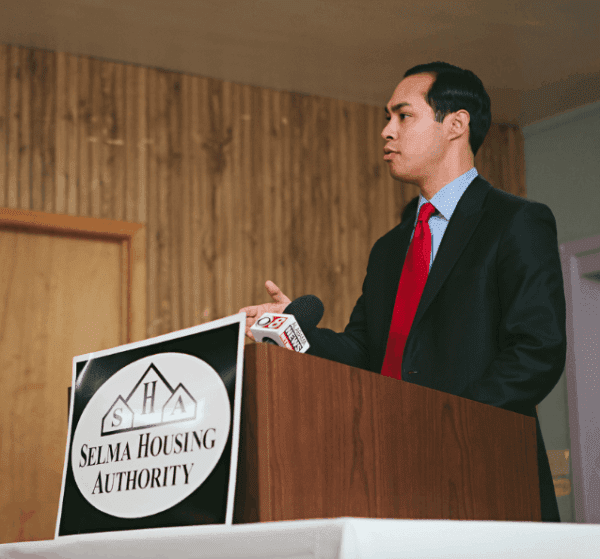
Julian Castro, President Obama’s last HUD Secretary, who oversaw AFFH.
Local governments would have to fill out numbingly complicated Assessment of Fair Housing (AFH) forms that report racial and economic data. AFFH also requires the “explicit” use of “fair housing planning.” AFHs must invite the public, “including individuals historically excluded because of characteristics protected by the Fair Housing Act, to provide input about fair housing issues, goals, priorities, and the most appropriate uses of HUD funds.”
In plain language, this means:
- The government will analyze neighborhoods in intensive detail, looking for anything less than total racial and economic integration. It’s a massive exercise in data-gathering that assumes “discrimination” caused any deviation from ideal diversity.
- It’s all about helping “protected classes” and consulting their representatives. They are the usual pets: non-whites, foreigners, etc. The word “protected” occurs 126 times in the 30-page AFH form. Every black church and Chicano association could be a “representative” and get its fingers in the pie.
- The new rule will fight “racial or ethnic concentrations of poverty” and expand “economic opportunity” by bringing poor people and non-whites (often the same people) to your neighborhood.
If local governments don’t do as they are told, they won’t get HUD money, including housing grants. HUD will get information about insufficiently diverse communities, get advice from leftist groups, and, potentially, remake the suburbs. Senator Mike Lee called AFFH a “national zoning board” that would “choose what should be built, where, and who should pay for it — in order to make your neighborhood look more like they want it to.”
“Section 8” is an important part of this plan. That’s the federal program that pays for housing for poor people. HUD gives the money to local Public Housing Authorities (PHAs), which pay landlords directly. This is a huge savings for poor tenants. Landlords would rather have people who can pay their own way, but at least they get a guaranteed rent check. If cities lose Section 8 money, landlords are stuck with deadbeats. Not surprisingly, most places have more people who want Section 8 housing than landlords willing to rent to them. When Section 8 housing opens up, locals want to house their own poor, not far-away strangers. That is one of the things AFFH could change; what HUD did to Dubuque, Iowa, would be a model.
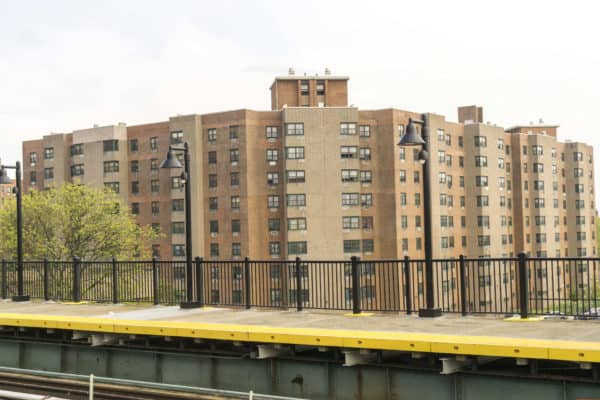
Riverdale Towers affordable housing in the Brownsville neighborhood of Brooklyn in New York. (Credit Image: © Richard B. Levine / Levine Roberts / Newscom via ZUMA Press)
In 2011, the Obama Administration investigated Dubuque because it gave Section 8 vouchers to its own residents. The city was more than 90 percent white, so almost all applicants were old white people. HUD said that was discrimination, and forced the city to sign a “voluntary compliance agreement” in 2014. Dubuque wasn’t discriminating against blacks, but it would have lost millions in housing money if it had told HUD to buzz off.
The city had to write “a history of race relations in Dubuque,” list its own policies that “operated as impediments to fair housing choice,” and “integrate affordable housing without regard to race or ethnicity.” Specifically, it had to “remove all residency preference point allotments.” That meant importing Section 8 voucher-holders, many of them from Chicago and many of them black. Like most places with a large black population, the Section 8 waiting list in Chicago is very long, so enterprising blacks made the 200-mile trip to Dubuque. Some local whites were edged out.
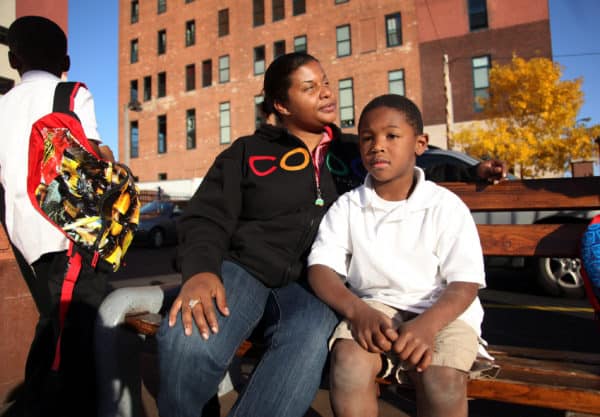
Theresa Saunders and her son Doobie Lenear, 6, sit outside People Serving People, where they have been living while they are on a waiting list for section 8 housing. (Credit Image: © TNS via ZUMA Wire)
If this export trade becomes common, big, black-run cities won’t bother to expand their own Section 8 programs. They could offload their poor. Combined with other ways to force integration, AFFH could be, as National Review wrote, the “end of local government in America.”
“Voluntary” agreements were a standard Obama administration tactic in education and policing as well. A “Dear Colleague” letter from the Department of Education forced schools to cut racial disparities in discipline by ending uniform treatment. If too many “students of color” were disciplined, the district could face an onerous federal investigation. The Obama Department of Justice forced consent decrees on local police to reduce racial differences in arrests and convictions. In housing, education, and crime, “disparate impact” was considered proof of racism.
A Hillary Clinton administration would probably have turned these edicts into permanent, national regulations. President Trump’s 2016 victory prevented this. Then-Attorney General Jeff Sessions ordered a review of all “consent decrees” in police departments. In 2018, the Department of Education and Justice Department issued a joint letter withdrawing the “Dear Colleague” letter from the Obama years.
Ben Carson criticized AFFH even before he became HUD secretary, and in 2020, he finally ended it. Senator Chris Murphy (D-CT) stupidly claimed that repealing AFFH meant President Trump was a “proud, vocal segregationist.”
Oh my. I mean, it’s not even a dog whistle anymore. Our President is now a proud, vocal segregationist. https://t.co/nGTY4zYwg1
— Chris Murphy (@ChrisMurphyCT) July 29, 2020
Was National Review overstating things when it wrote that AFFH could mean the “end” of local government? It’s hard to say, because the new order was never fully implemented. The feds love to wield power, and we get a hint of that in this passage from the final version of AFFH issued on July 16, 2015. It says HUD can step in when:
a significantly higher proportion of the jurisdiction’s black residents experience a severe cost burden when compared to the proportion of the jurisdiction’s white residents . . . [or] when a higher proportion of Hispanic individuals with limited English proficiency experience substandard housing conditions than the proportion of the state’s population that experiences substandard housing conditions.
There are probably countless places that meet these criteria, and it’s not clear just how much bullying these conditions would justify. Would whites who struggle to pay rent get relief? Unlikely. The word “Asian” didn’t even appear in the rule.
AFFH worries that “a partnership of all-white communities” could set up a regional AFH that would “mask the fair housing issues in their jurisdictions.” Presumably, this means that Beverly Hills or Grosse Pointe Park, or other pleasant places with few non-whites and little Section 8 housing might try to claim AFFH doesn’t apply. HUD has them covered: This would not relieve them from the obligation of “analyzing and addressing fair housing issues and contributing factors.” Presumably, if no blacks live in your town, you have to eliminate the “racism” that kept them out.
But some communities don’t have to worry about HUD bludgeoning. “[N]eighborhoods with racially/ethnically concentrated areas of poverty” might face “gentrification,” and “it is important to retain the character of communities while investing more resources in the area rather than attempting to remove people who have cultural, ethnic and historical connections to their neighborhoods.” What does that mean? You would think gentrification brings exactly what HUD wants — integration — but not if non-whites don’t want it. They can keep the flavor of their neighborhoods; whites can’t.
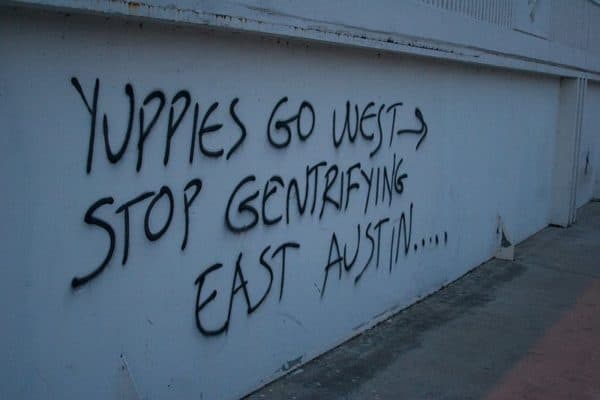
Credit Image: Roland Tanglao via Wikimedia
Interestingly, in 2015, the time when AFFH was announced, a poll found that 83 percent of voters said it’s not the government’s job to promote neighborhood diversity. That was up from 74 percent two years earlier. Once again, the people know better than their rulers.
What was the statutory justification for pushing AFFH? The 1968 Fair Housing Act. The AFFH rule admitted the Fair Housing Act had limited ambitions: stop deliberate racial discrimination in housing. However, the rule claimed that when subsequent legislation introduced the idea that HUD had an obligation to “affirmatively further fair housing,” this changed everything.
What do those words mean? When Secretary Carson shut down AFFH, he wrote: “Hanging a massively intrusive regulatory structure on such a cryptic, four-word phrase is inconsistent with the separation of the bedrock principles of separation of powers.”

President Donald J. Trump and Ben Carson. (Credit Image: © Michael Reynolds / Avalon via ZUMA Press)
A Biden administration could decide those words are crystal clear. We have seen this time and again. Prohibiting racial discrimination — in hiring, college admissions, school discipline, housing — does not lead to the equal results our rulers want. Even preferences for blacks and Hispanics aren’t enough. So the goalposts keep shifting. Not even “conservatives” dare talk about inherent racial differences, so we have to invent “systemic racism” and “white privilege” to explain inequality.
Laws requiring equal treatment cannot produce equal outcomes, so the very legislation that forbade discrimination had to be reinterpreted to require it. This is what Christopher Caldwell meant when he argued that the civil rights revolution replaced the Constitution with a new order.
Unless Americans understand that race is real and has consequences, this revolution will never end. BLMania has pushed the fight against “systemic racism” into every corner of American life. A Democrat-controlled HUD could take the fight into your backyard.
Our “civil rights” laws were unjust even before they were perverted into tools for discrimination. We must demand a return to freedom of association. Real “fair housing” would let Americans live wherever they want, with whomever they want. For a Biden-Harris administration determined to “root out systemic racism,” deciding who your neighbors are could be only the beginning. We rose up against George III for far less.















